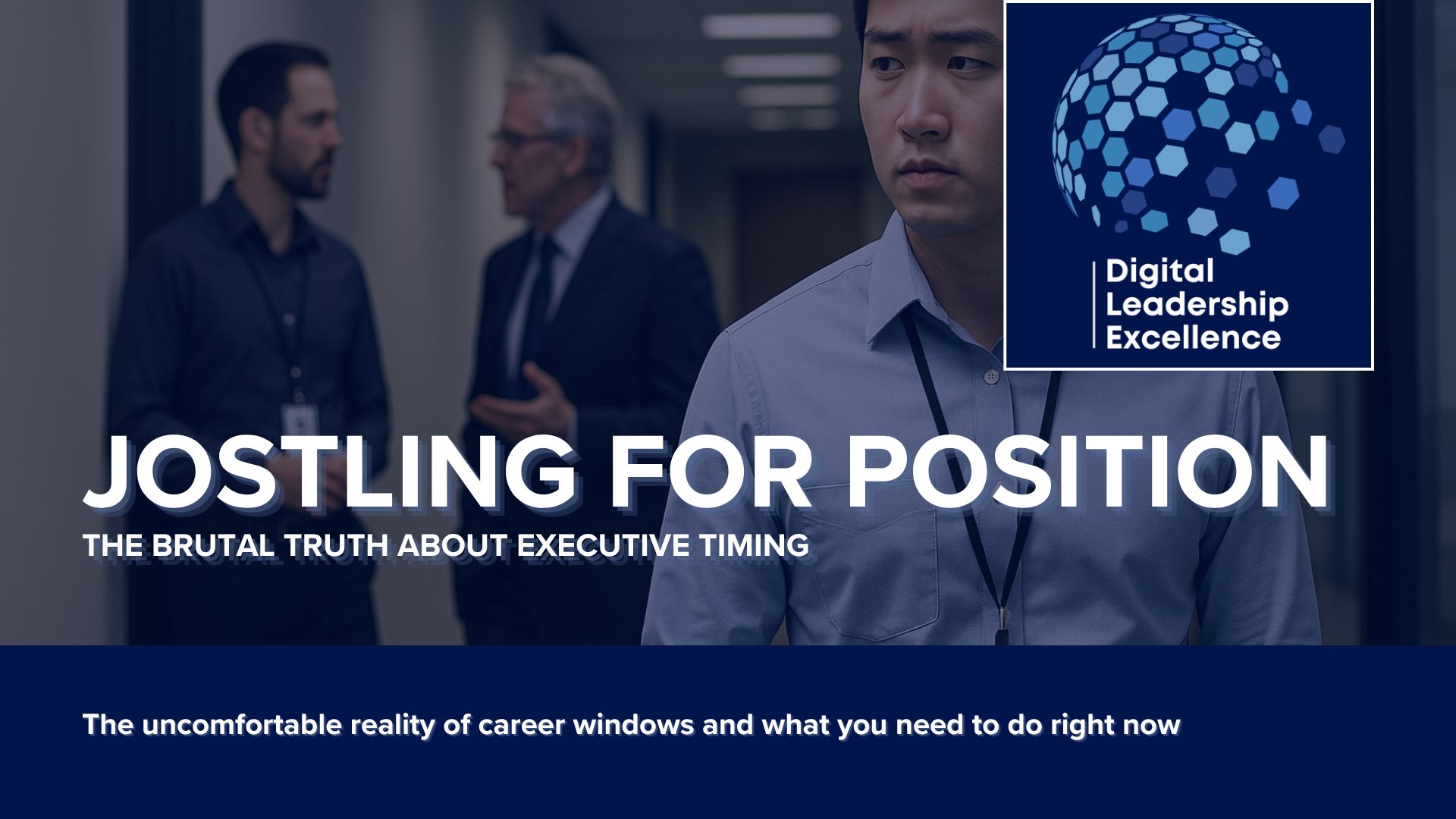- Digital Leadership Excellence
- Posts
- #58 Jostling for Position: The brutal truth about Executive Timing
#58 Jostling for Position: The brutal truth about Executive Timing
The uncomfortable reality of career windows and what you need to do right now

Greetings, and welcome to Digital Leadership Excellence — Your trusted weekly guide to excelling in tech leadership, delivering results, and thriving with clarity and purpose. In every issue, we provide insights into winning strategies, growth tactics, and practical solutions, designed to support both current and aspiring technology leaders navigating the ever-evolving digital world.
1.0 Introduction
Here's what nobody tells you when you're climbing the leadership ladder:
There's a window.
A narrow one.
And if you miss it, getting to the C-suite becomes exponentially harder. Not impossible. But harder in ways that have nothing to do with your capabilities.
These are not my value judgments and they’re not my rules…it is what I have empirically observed after coaching 100s of executives for years.
Let me be direct about something most leadership content dances around: age matters. Timing matters. And waiting until you feel "fully prepared" is the strategy that keeps talented executives stuck at the Director or VP level forever.
I'm going to walk you through why this happens, what the actual window looks like, and what you need to do about it right now. Not next quarter. Not after your next big project. Now.

2.0 The Window Most Don't See
In my work with technology executives, I see this pattern constantly. Someone reaches Director level in their late 30s. They're crushing it. Delivering results. Building their expertise. Waiting for the next opportunity.
That opportunity comes. They interview. They don't get it.
"Not quite ready yet," they're told. "Need a bit more executive presence." Or "Looking for someone with broader business acumen."
Fair enough, they think. I'll keep developing. I'll prove myself on the next initiative. I'll be ready next time.
Next time comes. Same result. Different reason.
By the time they hit their late 40s, the feedback shifts. Still not getting the role. But now the quiet part is: "We were expecting this to have happened already."
Wait? What? - weren't they "not ready" just a few years ago? Now they're too late?
Yes. Because the window isn't about capability. It's about perception of trajectory.

3.0 An Uncomfortable Truth
Most companies have a mental model of what an "ascending executive" looks like. And that model includes assumptions about timing. If you haven't made certain leaps by certain points, they start to wonder why. Not out loud. But it affects their confidence in promoting you.
The technology executives who break through to the C-suite? They understand this. They don't wait for readiness. They position for visibility.
Let me show you what I mean:
Two directors. Same company. Same technical depth. Both respected. Both delivering results.
Director A focuses on execution excellence. Crushing their goals. Building impressive technical capabilities. Waiting to be tapped for bigger things.
Director B does something different. They start showing up at strategy meetings they aren't required to attend. They schedule coffee with the CFO to understand how the company measures success. They volunteer for cross-functional initiatives that have board visibility. They reframe their project updates in terms of business impact, not technical achievement.
Three years later, Director B is the CIO. Director A is still Director A, wondering what they missed.
What did they miss?
The understanding that positioning happens before the opportunity opens. Not after.
4.0 The typical pattern I see
Phase 1 (Late 30s - Early 40s): "I need to keep proving myself. Build my credibility. Show I can handle bigger scope."
Phase 2 (Mid 40s): "I should probably start thinking about executive positioning. But let me finish this transformation first."
Phase 3 (Late 40s - Early 50s): "Why am I not being considered for these roles? I'm more qualified than the people getting promoted."
Phase 4 (Mid 50s+): "I guess I'm not going to make it to the C-suite. Maybe I should look at board positions or consulting."
Each phase made sense in the moment. The problem? By the time most people realize they need to shift from proving to positioning, they've already missed their optimal window.
Why does this window exist?
Organizations make bets on leaders. They're not promoting you based on what you've done. They're promoting you based on their confidence in what you can do at the next level.
And here's the reality: they have more confidence in someone who's been on an ascending trajectory than someone who's been steady at the same level.
Two candidates. One has moved from Manager to Director to VP to SVP over 10 years. The other has been a Director for 12 years and is now trying to jump to CIO.
Who gets the role?
The ascending candidate. Even if the long-tenured Director has deeper expertise.
Because trajectory signals something. It says other organizations bet on this person. It says they've been tested at increasing levels of responsibility. It says the next leap isn't as risky.
Fair? No. Real? Yes.
Don’t shoot the messenger.

5.0 What to do about this
First, stop measuring yourself by readiness. That's not the game.
The game is perception of capability. And perception is built through visibility, positioning, and the story people tell about your trajectory.
Let me break down what this actually looks like in practice.
Visibility isn't about self-promotion. It's about strategic presence.
You need to be in rooms where executive decisions are discussed. Not just informed of decisions after they're made. Actually in the room while they're being shaped.
How do you get there? You create reasons for your presence to be valuable. You bring business insight to technical discussions. You connect technology initiatives to strategic priorities in ways that make executives want your perspective.
Example: You're leading a cloud migration. Most technology leaders present this as a technical initiative. Timelines, architecture, risk mitigation. All important. None of it creates executive visibility.
The leader who gets visibility? They frame it differently. They show up to finance meetings explaining how this migration impacts our cost structure and creates flexibility for M&A. They present to the board on how this positions us competitively. They connect the technical work to business outcomes the CEO cares about.
Same project. Different positioning. Different trajectory.
6.0 Changing the Narrative
Positioning is about changing the story people tell about you.
Right now, executives have a story about you. Maybe it's "brilliant technologist." Maybe it's "solid operator." Maybe it's "the person who fixes our problems."
None of those stories lead to the C-suite.
The story that leads to the C-suite? "Strategic business leader who happens to have technology expertise."
Different story. And you have to deliberately construct it through your actions, your language, and your focus.

Here's what this looks like:
Stop opening presentations with technical details. Start with business impact. Don't lead with "we're implementing a new security framework." Lead with "we're reducing our regulatory risk exposure by 40% while enabling faster customer onboarding."
Stop positioning yourself as the solver of technical problems. Start positioning yourself as the architect of business capabilities. The difference? One makes you indispensable at your current level. The other makes you promotable.
Stop waiting for strategy meetings to be handed to you. Start creating reasons for your input to be valuable in those discussions. Develop perspectives on market dynamics, competitive positioning, customer experience. Make yourself someone whose absence is noticed in strategic conversations.
7.0 The specific moves that create positioning
Build relationships with decision-makers before you need them. Not networking for its own sake. Genuine relationships where you're providing value, sharing insights, being a strategic thought partner.
Learn the language of business impact. Revenue, margin, customer lifetime value, competitive advantage, risk mitigation, operational leverage. Get fluent in how the C-suite measures success.
Take on cross-functional leadership. Volunteer for initiatives that have board visibility. Not because you have capacity, but because visibility compounds. The more you're seen leading cross-functionally, the more you're seen as executive material.
Reframe your current work. You're probably already doing strategic work. You're just describing it tactically. Change how you talk about what you do. Business outcomes first. Technical execution second.
Get executive coaching or mentorship from someone who's actually made this transition. Not someone who'll make you feel good about where you are. Someone who'll tell you the uncomfortable truth about what's actually holding you back.
8.0 Here's what I need you to understand
If you're in your early 40s and thinking "I have time," you don't. You have a window. Maybe five years. Use them strategically.
If you're in your mid 40s and thinking "I'm close," you're actually at decision point. The moves you make in the next 18-24 months will determine whether you make the leap or plateau.
If you're in your late 40s and thinking "maybe I missed it," you haven't. But you need to move decisively. The window is narrower. The positioning needs to be more aggressive. The relationship building needs to accelerate.
And if you're in your early 50s thinking "I guess it's not going to happen," stop. It can still happen. But not by continuing what you've been doing. You need a different strategy entirely.
The Bottom Line
Stop waiting to be ready. Start positioning to be impossible to overlook.
Stop proving your technical competence. Start demonstrating your strategic value.
Stop hoping someone will notice your work. Start making your impact visible to the people who make advancement decisions.
And stop thinking you have unlimited time. You don't. None of us do.
The executives who make it to the C-suite aren't necessarily more capable than those who don't. They're just better at understanding the game and positioning themselves accordingly.
The clock is ticking.
What are you going to do about it?
Robert

Robert Castle
Founder | DIGITAL LEADERSHIP EXCELLENCE
What did you think of today’s Newsletter?select below |
Reply